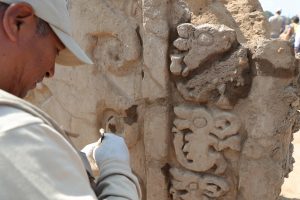
Trujillo, Peru, Jun 15 (EFE).- The discovery of new murals carved in high relief at the archaeological complex of Chan Chan, the largest pre-Columbian city built of adobe in the Americas, shows once more that it still has surprises in store for archaeologists, thanks to the information it keeps adding about the Chimu, its ancient inhabitants.
Researchers at these archaeological digs in the northern region of La Libertad, declared a UNESCO World Heritage Site, have newly discovered a corridor with murals in the excavations at Utzh An (Large House, in the Quinqnam or Chimu language).
This is one of the 10 walled areas that make up Chan Chan, whereas a third system of stairways has also been discovered in the so-called “huaca,” or sacred monument, of Toledo.
Peruvian Culture Minister Patricia Balbuena, who arrived at the arquaeological site on Thursday to officially present the new finds, said the careful conservation work undertaken at Chan Chan preserved the ruins from being destroyed during the recent downpours.
She also spoke of the investments made by the Culture Ministry in the Chan Chan project, though she noted that it will be “necessary to count on more funding,” and asked that more and larger strategic alliances be established with the private sector.
These newly discovered murals date back to the years 1200-1350 A.D. and have high-relief decorations with oceanic motifs, squares and waves, along with a “lunar animal,” a mythical symbol of different pre-Columbian cultures of the Peruvian coastline.
According to Henry Gayoso Rullier, the archaeologist leading the restoration of this part of the Utzh An walled complex, these newly recovered ruins formed part of a main patio, as shown by the way they are decorated.
Besides this mural measuring 590 x 370 meters (1,935 x 1,214 feet), another of the discoveries is decorated with feline figures plus more waves and squares, and measures approximately 2.3 by 2 meters.
The Chimu culture, heir of the previous Mochica era, developed on the north coast of Peru between the years 1100 and 1400 A.D., until its people were conquered by the Incas when its leader Minchancaman was defeated by Pachacutec, and became a province of the Inca Empire until the arrival of the Spaniards.
